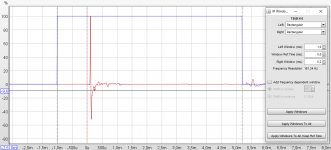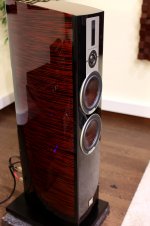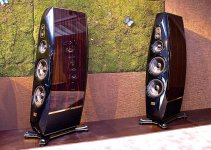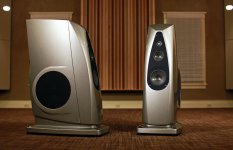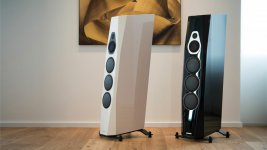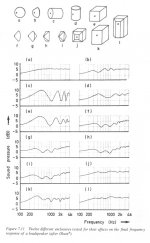Yes, I've got that on %. I'll read it.
I can see a very clear reflection at about 3ms in that graph. that seems typical for an in room measurement. its probably either the floor or the back wall. Gate before the reflection. You can trust the data above probably ~400hz
you might also take a number of measurements at slightly different angles and then gate them all, then average. will give you a clearer idea of what is happening.
EDIT: maybe post the SPL graph of the truncated measurement, looks like there is a MASSIVE boost at 2-3 k and a loss in the top octave. this is pretty likely to explain why you arn't liking the sound on anything expect jazz
Last edited:
This is what the setup looks like.
We were also talking about mechanical/acoustic design. That shape looks quite bad. Close to maximum diffraction effects due to sharp edge and constant distance from the center of tweeter to edge on the top. Everything cannot be fixed with crossover though decent sound balance is possible. Dependence on listening distance, direction and environment still remains in addition to possibly fragmented sound stage.
The gating as shown in post #71 is still not right. You are missing a big part of the initial pulse response this way. Small wonder you are missing some of the high frequencies on your graph. And you shouldn't go further than 3 ms after the pulse.
Regards
Charles
Regards
Charles
Does someone need to say it? You can make improvements in the end, they do take longer to get the smaller improvements, it is absolutely worth it if you have the time, it can be based on modern ideas of room interaction.. not only balance, but where and when each reflection happens.You could do, but nothing here shows that results are really better regardless of 10x longer design time. At least it's very difficult to believe because methods are really ancient and poor.
For the purpose of this discussion, the gate time starts when the direct sound first arrives, and is ended when the reflection first arrives.Then I still don't understand why I have to substract the speaker-mic distance.. I'm trying to filter out the first reflections. So then the gate must be set right befor the reflections arrive?
The gating as shown in post #71 is still not right. You are missing a big part of the initial pulse response this way. Small wonder you are missing some of the high frequencies on your graph. And you shouldn't go further than 3 ms after the pulse.
Regards
Charles
charles, I dont think you can see the left gate? its offscreen. so it should have everything I think?
I created the picture below to show correct placement of the impulse on timeline. This way whole impulse is on the right from T=0, this is important to get the phase right, which is important when doing dual chanel measurement for crossover design. It also shows correct setting of the gate, and the first strong reflection is clearly identifiable.
Originaly the impulse is placed in T= ~3ms when one measures from 1m. In my case, I shifted the impulse by ~2.9ms to the left, to compensate travel delay and phase wraps in the graphs, which makes work on phase tracking easier.
This was indoor, gated measurement of the tweeter.
3wayaddict: you should be able to achieve something like this also in your conditions, just strong first reflection will be closer.
Originaly the impulse is placed in T= ~3ms when one measures from 1m. In my case, I shifted the impulse by ~2.9ms to the left, to compensate travel delay and phase wraps in the graphs, which makes work on phase tracking easier.
This was indoor, gated measurement of the tweeter.
3wayaddict: you should be able to achieve something like this also in your conditions, just strong first reflection will be closer.
Attachments
Last edited:
...absolutely worth it if you have the time...
Time is not endless resource so (controlled) speed in very basic design operations opens possibilities to do more and different. More time to learn, evolve and increase quality - if that's the goal. But this was not my main point. I'll take my coat...
We were also talking about mechanical/acoustic design. That shape looks quite bad. Close to maximum diffraction effects due to sharp edge and constant distance from the center of tweeter to edge on the top. Everything cannot be fixed with crossover though decent sound balance is possible. Dependence on listening distance, direction and environment still remains in addition to possibly fragmented sound stage.
Yes, it looks good but the acoustic results now seem a lot worse than I expected. I will change the round top for a square top as I already showed to get less equalbdistances from the tweeter to the edge.
The edge is chamfered, only very little, about 1 cm. I was planning on chamfering it 2,5 cm but the woodwork shop I got my wood done didn't have a 2,5 cm radius mill. When I'm building the next pair I will do whatever it takes to get the 2,5 cm chamfering. I'll contact a friend of mine who is a woodworker. He has a 2,5 cm mill for shure. The square top and larger chamfering shouldbdefinately improve FR.
I'd be tempted to attack them with a flap disk on an angle grinder ( using a templet ) then making a wooden block with the right radius to use with sandpaper to finish them. This is how I got the radius on my box in a box speakers. It'd save you making another pair.
I'm going to build another pair anyway. There are a few small things I want to improve and I want to get them finished.
The amps are now mounted on the back and the speakers cables now stick right out of the cabinet (sealed with silicone), very unprofessional. So instead of having the cables stick out of the cabinet, I will be mounting nice Furutech binding posts and have the amplifiers separate from the speakers. Looks neater and helps isolate the amps from any vibrations, increasing performance.
Also, the faceplate of the new BliesMa tweeter is 1 mm thicker than that of the Satori, so it slightly sticks out now, which I also want to fix.
And even though it's invisible from the outside and doesn't cause any problems. I'm not happy how the cables are routed internally through the midrange chamber. I've now designed in a cable channel behind the midrange chamber.
Now I also want to do the slight redesign of the top of the speaker.
The main reason I'm building a new pair is because I'm gonna have them finished by a company who renovate and finish Riva's. But the current pair is put together too bad the be able to finish it nicely. And the sides are gonna be veneered so the front baffle has to stick out 1 mm so it's flush with the veneer. They will be veneered with macassar ebony. The front will be painted dark silver and the will be treated with 4 layers of epoxy and 6 layers a lacquer, and will be polished. So they will look somwhat like the DALI Epicon series, but with the wood grain vertically.
Because I'm building a new set anyway so it can be finished, I can also do the improvements above.
The amps are now mounted on the back and the speakers cables now stick right out of the cabinet (sealed with silicone), very unprofessional. So instead of having the cables stick out of the cabinet, I will be mounting nice Furutech binding posts and have the amplifiers separate from the speakers. Looks neater and helps isolate the amps from any vibrations, increasing performance.
Also, the faceplate of the new BliesMa tweeter is 1 mm thicker than that of the Satori, so it slightly sticks out now, which I also want to fix.
And even though it's invisible from the outside and doesn't cause any problems. I'm not happy how the cables are routed internally through the midrange chamber. I've now designed in a cable channel behind the midrange chamber.
Now I also want to do the slight redesign of the top of the speaker.
The main reason I'm building a new pair is because I'm gonna have them finished by a company who renovate and finish Riva's. But the current pair is put together too bad the be able to finish it nicely. And the sides are gonna be veneered so the front baffle has to stick out 1 mm so it's flush with the veneer. They will be veneered with macassar ebony. The front will be painted dark silver and the will be treated with 4 layers of epoxy and 6 layers a lacquer, and will be polished. So they will look somwhat like the DALI Epicon series, but with the wood grain vertically.
Because I'm building a new set anyway so it can be finished, I can also do the improvements above.
Attachments
Yes, I like the shape and the constant distance to the edge. A roundover would be prudent, and better than using the squared shape.I'd be tempted to attack them with a flap disk on an angle grinder ( using a templet ) then making a wooden block with the right radius to use with sandpaper to finish them. This is how I got the radius on my box in a box speakers. It'd save you making another pair.
I'd think a square top with bigger chamfering would make for a more even FR?
That way the Baffle would actually have the same shape as the design like that of a Tidal or Rockport speaker. Except because those boxes are rectangular and mine gets narrower to the top, the corners are cut off. But the baffle in effect has the same shape. And I think baffles of the shape like that of a Tidal or Rockport are the best designs. Which I have seen reviewed in a study about baffle design and resulting FR.
That way the Baffle would actually have the same shape as the design like that of a Tidal or Rockport speaker. Except because those boxes are rectangular and mine gets narrower to the top, the corners are cut off. But the baffle in effect has the same shape. And I think baffles of the shape like that of a Tidal or Rockport are the best designs. Which I have seen reviewed in a study about baffle design and resulting FR.
Attachments
Last edited:
How about just sliding the amps underneath the speakers from the rear, having a false bottom so they'd be hidden.
Only if you don't fix the diffraction with a roundover. Using the square shape instead can give problems on other axes.I'd think a square top with bigger chamfering would make for a more even FR?
I would round over/chamfer the edges on the new square box, with a much bigger radius than on the current enclosures. Her is the study about enclosure shape and resulting frequency response. With the square top and chamfered edges my speaker would be the closest to the "L". Which has one of the smoothest frequency responses.
Attachments
Last edited:
Moving the Fusionamps to the bottom of the cabinet is not the best idea, I think it's mentioned in the manual, they needs good airflow around them too.
How about just sliding the amps underneath the speakers from the rear, having a false bottom so they'd be hidden.
That would be unpractical since I wouldn't be able to reach the power button and connectiong the cables would be very inconvenient. And the main reason for separating the amps from the speakers is not for the looks. For looks they're fine on the back. It's about the performance. I want to isolate the amps from any vibrations. This will be beneficial to their performance. Especially because the have digital stuff and DACs inside which are very sensitive to vibrations.
The digital section is not sensitive to vibration, why would it be? This is not phono cartridge...
Digital is definately sensitive to vibrations. Just as much as things like tubes. Especially clocks. When clocks get vibrated the become very inaccurate and cause jitter, which causes distortion.
For this reason high end digital components have got very rigid and well damped enclosures. For the same reason recently a lot of advanced damping feet for under equipment like those from Isoacoustics have showed up on the market.
For this reason high end digital components have got very rigid and well damped enclosures. For the same reason recently a lot of advanced damping feet for under equipment like those from Isoacoustics have showed up on the market.
- Home
- Loudspeakers
- Multi-Way
- In need of warmth
